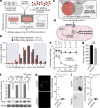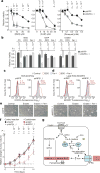NFS1 undergoes positive selection in lung tumours and protects cells from ferroptosis
- PMID: 29168506
- PMCID: PMC5808442
- DOI: 10.1038/nature24637
NFS1 undergoes positive selection in lung tumours and protects cells from ferroptosis
Erratum in
-
Author Correction: NFS1 undergoes positive selection in lung tumours and protects cells from ferroptosis.Nature. 2022 Sep;609(7929):E12. doi: 10.1038/s41586-022-05323-7. Nature. 2022. PMID: 36104569 No abstract available.
Abstract
Environmental nutrient levels impact cancer cell metabolism, resulting in context-dependent gene essentiality. Here, using loss-of-function screening based on RNA interference, we show that environmental oxygen levels are a major driver of differential essentiality between in vitro model systems and in vivo tumours. Above the 3-8% oxygen concentration typical of most tissues, we find that cancer cells depend on high levels of the iron-sulfur cluster biosynthetic enzyme NFS1. Mammary or subcutaneous tumours grow despite suppression of NFS1, whereas metastatic or primary lung tumours do not. Consistent with a role in surviving the high oxygen environment of incipient lung tumours, NFS1 lies in a region of genomic amplification present in lung adenocarcinoma and is most highly expressed in well-differentiated adenocarcinomas. NFS1 activity is particularly important for maintaining the iron-sulfur co-factors present in multiple cell-essential proteins upon exposure to oxygen compared to other forms of oxidative damage. Furthermore, insufficient iron-sulfur cluster maintenance robustly activates the iron-starvation response and, in combination with inhibition of glutathione biosynthesis, triggers ferroptosis, a non-apoptotic form of cell death. Suppression of NFS1 cooperates with inhibition of cysteine transport to trigger ferroptosis in vitro and slow tumour growth. Therefore, lung adenocarcinomas select for expression of a pathway that confers resistance to high oxygen tension and protects cells from undergoing ferroptosis in response to oxidative damage.
Figures











References
-
- Vaupel P, Kallinowski F, Okunieff P. Blood flow, oxygen and nutrient supply, and metabolic microenvironment of human tumors: a review. Cancer Res. 1989;49:6449–6465. - PubMed
-
- Stehling O, Wilbrecht C, Lill R. Mitochondrial iron–sulfur protein biogenesis and human disease. Biochimie. 2014;100:61–77. - PubMed
Publication types
MeSH terms
Substances
Grants and funding
- P30 CA016087/CA/NCI NIH HHS/United States
- K99 CA168940/CA/NCI NIH HHS/United States
- S10 OD016304/OD/NIH HHS/United States
- T32 GM115313/GM/NIGMS NIH HHS/United States
- R37 AI047389/AI/NIAID NIH HHS/United States
- S10 OD010584/OD/NIH HHS/United States
- R01 CA129105/CA/NCI NIH HHS/United States
- R00 CA168940/CA/NCI NIH HHS/United States
- T32 AI007389/AI/NIAID NIH HHS/United States
- CA168940/NH/NIH HHS/United States
- R01 CA103866/CA/NCI NIH HHS/United States
- S10 OD010584-01/NH/NIH HHS/United States
- K22 CA193660/CA/NCI NIH HHS/United States
- T32 GM007308/GM/NIGMS NIH HHS/United States
- S10 OD018338/OD/NIH HHS/United States
LinkOut - more resources
Full Text Sources
Other Literature Sources
Medical
Molecular Biology Databases
Research Materials

